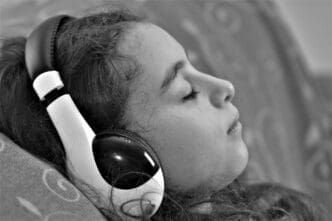Music therapy, a clinical and evidence-based practice, is increasingly recognized for its profound ability to alleviate symptoms of anxiety by leveraging the brain’s innate response to sound. While many factors contribute to music’s calming effects, a growing body of research and widespread public interest now focus on whether specific sound frequencies can directly influence brainwave patterns and physiological stress responses. For individuals grappling with anxiety, therapists and researchers are exploring how auditory tools, from binaural beats to specific musical tunings, can be used to shift the nervous system from a state of high alert to one of calm, offering a non-invasive and accessible path toward mental well-being.
Understanding Music Therapy and Its Role in Mental Health
Before diving into the specifics of frequencies, it’s crucial to understand what music therapy is—and what it is not. It is far more than simply creating a relaxing playlist or listening to calming sounds on an app. The practice is a well-established allied health profession, similar to occupational or physical therapy.
The American Music Therapy Association (AMTA) defines it as the clinical and evidence-based use of music interventions to accomplish individualized goals within a therapeutic relationship. This is facilitated by a credentialed professional who has completed an approved music therapy program.
What Is Clinical Music Therapy?
In a clinical setting, a board-certified music therapist (MT-BC) assesses a client’s emotional well-being, physical health, social functioning, and cognitive skills through musical responses. They then design specific interventions, which can be active or receptive. Active interventions might involve the client creating music, whether through singing, composing, or playing an instrument.
Receptive interventions, on the other hand, involve listening to music and responding to the experience, such as through relaxation exercises or discussion. The therapist guides this process, helping the client process emotions, develop coping mechanisms, and achieve therapeutic goals. It is a dynamic and interactive process tailored to the individual’s needs.
Music as a Therapeutic Tool
The power of music therapy comes from its multi-faceted impact on the brain and body. It can provide a non-verbal outlet for emotions that are too difficult to articulate. The act of creating music can build self-esteem and a sense of agency, while synchronizing with a rhythm can foster a sense of connection and grounding. For anxiety, these elements work together to create a holistic therapeutic effect.
The Science of Sound: How Music Affects the Anxious Brain
The reason music can so effectively soothe anxiety lies in its direct line to the brain’s core emotional and regulatory centers. When we hear music, sound waves are converted into electrical signals that travel to the auditory cortex, but their journey doesn’t stop there. These signals cascade through various brain regions, including the limbic system, which governs emotion and memory, and the brainstem, which controls basic physiological functions.
The Autonomic Nervous System Response
Anxiety is largely driven by the sympathetic nervous system, our “fight-or-flight” response mechanism. This system increases heart rate, elevates blood pressure, and floods the body with stress hormones like cortisol. Music, particularly music with a slow tempo and consistent rhythm, can activate the opposing parasympathetic nervous system, our “rest-and-digest” mechanism.
This counter-response slows the heart rate, deepens breathing, and relaxes muscles. The predictable and orderly nature of certain musical structures can signal to a hypervigilant brain that it is safe to stand down, effectively reducing the physiological symptoms of anxiety.
Brainwave Entrainment: A Key Mechanism
Our brains operate on a constant hum of electrical activity, producing patterns known as brainwaves. These are categorized by their frequency: Beta waves (13-30 Hz) are associated with active, alert consciousness, which can become excessive in anxious states. Alpha waves (8-12 Hz) are linked to a state of calm, relaxed wakefulness. Theta waves (4-7 Hz) are present during deep meditation and light sleep, while Delta waves (0.5-4 Hz) occur during deep, dreamless sleep.
The theory of brainwave entrainment suggests that the brain has a tendency to synchronize its own electrical cycles to the rhythm of external stimuli. By listening to sound patterns at a specific frequency, it may be possible to encourage the brain to shift its dominant brainwave pattern. For example, listening to a rhythm in the Alpha range could theoretically help an anxious, Beta-dominant brain slow down into a more relaxed state.
The Controversy and Promise of Specific Frequencies
This concept of brainwave entrainment is the scientific foundation for claims about specific “healing” frequencies. While some of these claims are supported by emerging research, others venture into the realm of pseudoscience. It is vital to distinguish between the two.
Binaural Beats and Isochronic Tones
Among the most studied frequency-based tools are binaural beats. This phenomenon occurs when you listen to two slightly different frequencies in each ear through headphones. For example, if you hear 200 Hz in your left ear and 210 Hz in your right, your brain perceives a third, phantom tone at the difference between the two—in this case, 10 Hz. This 10 Hz frequency falls within the Alpha brainwave range.
Several small-scale studies have suggested that listening to binaural beats in the Alpha or Theta range can reduce anxiety scores and lower cortisol levels. Isochronic tones work on a similar principle of entrainment but use a single, distinct tone that pulses on and off at a specific rate. Because they don’t require headphones, some find them more accessible. While more research is needed, these tools represent a promising area of study for anxiety management.
The Debate Around 432 Hz vs. 440 Hz
A popular claim in many wellness communities is that music tuned to a standard of A=432 Hz is more calming and “in tune with the universe” than the modern standard of A=440 Hz, which was formally adopted in the 20th century. Proponents argue that 432 Hz has a more mathematically pure relationship to natural phenomena and feels subjectively warmer and more soothing.
However, these claims are not supported by rigorous scientific evidence. Studies comparing the physiological effects of music at 432 Hz versus 440 Hz have found no significant differences in heart rate, blood pressure, or self-reported anxiety. The perceived calming effect is more likely attributable to personal belief, placebo, and the style of the music itself rather than the tuning standard.
Solfeggio Frequencies: Ancient Myth or Modern Medicine?
Even more speculative are the claims surrounding Solfeggio frequencies, a set of specific tones (e.g., 396 Hz for liberating guilt, 528 Hz for “transformation and miracles”) said to have ancient healing properties. These beliefs are rooted in numerology and historical interpretations that lack scientific validation.
While a person may find a drone at 528 Hz to be relaxing, there is no credible scientific research to suggest this specific frequency has unique DNA-repairing or anxiety-curing properties beyond what any other calming sound might offer. The therapeutic benefit derived is likely due to the act of mindful listening and the placebo effect, not an intrinsic property of the frequency itself.
Beyond the Frequency: What Truly Makes Music Therapeutic for Anxiety
Focusing solely on specific frequencies misses the bigger, more evidence-backed picture. The true therapeutic power of music for anxiety comes from a combination of factors that are both universal and deeply personal.
The Importance of Tempo and Rhythm
One of the most robust findings in music psychology is the effect of tempo. Music with a slow tempo, around 60 to 80 beats per minute (BPM), closely mimics a healthy resting heart rate. This can subconsciously encourage our own heart rate to slow down, inducing a state of calm. Simple, predictable rhythms are far more effective at reducing anxiety than complex, syncopated, or jarring music.
Personal Preference and Emotional Resonance
Ultimately, the most calming music for an individual is music they enjoy. A scientifically “perfect” ambient track tuned to 432 Hz will have no therapeutic benefit if the listener finds it boring or irritating. Conversely, a familiar and beloved song, even if it has a faster tempo, can evoke powerful feelings of safety, nostalgia, and happiness that override the physiological stress response. The emotional connection to the music is paramount.
The Role of a Music Therapist
This is where a professional music therapist becomes invaluable. They can help a client explore their personal relationship with music and identify the specific elements—be it a certain genre, instrument, or tempo—that work best for them. They provide structure, guidance, and a safe space to process the emotions that arise during listening, which is a far deeper intervention than passively listening to a playlist.
Practical Steps for Using Music to Manage Anxiety
For those looking to use music as a self-help tool for managing mild anxiety, there are several evidence-informed strategies to try.
Creating Your Own Anxiety-Relief Playlist
When curating a playlist, prioritize music that is slow, simple, and predictable. Instrumental music is often ideal, as lyrics can sometimes be distracting or emotionally triggering. Look for pieces with a tempo between 60-80 BPM, minimal dynamic shifts, and a soothing melodic structure. Experiment with different genres, from classical and ambient to lo-fi hip-hop.
Mindful Listening Practices
Instead of having music on as background noise, set aside 10-15 minutes for active, mindful listening. Sit comfortably, close your eyes, and focus solely on the sound. Pay attention to the different instruments, the rhythm, and the texture of the music. This practice anchors you in the present moment, functioning as a form of meditation that can quiet anxious thoughts.
When to Seek a Professional Music Therapist
If anxiety is persistent, severe, or interfering with your daily life, it is important to seek professional help. A music therapist can offer targeted interventions that go beyond simple relaxation. They are trained to help individuals with diagnosed anxiety disorders, trauma, and other mental health conditions, using music as a powerful clinical tool within a comprehensive treatment plan.
Conclusion
The question of whether specific frequencies can reduce anxiety is a nuanced one. Auditory tools like binaural beats show legitimate promise and are backed by emerging scientific inquiry, offering a direct method for influencing brainwave activity. However, many other claims about “healing” frequencies lack scientific support and should be approached with skepticism. The most reliable evidence points not to a single magic frequency, but to the broader, more holistic qualities of music: a slow tempo, a predictable rhythm, and—most importantly—a deep personal and emotional connection. While listening to calming music is a powerful self-help tool, the practice of clinical music therapy with a credentialed professional offers the most profound and targeted path for harnessing the full healing potential of sound.












